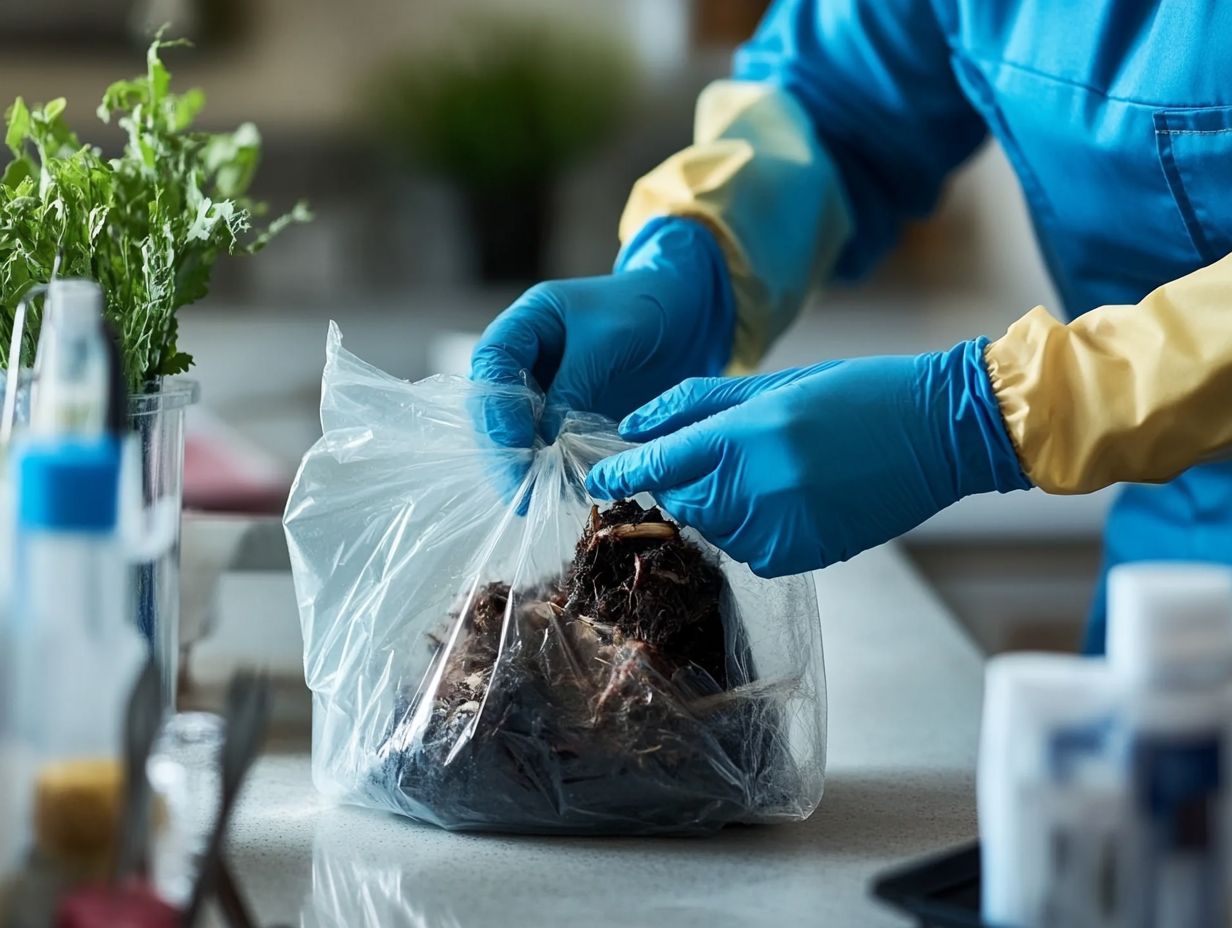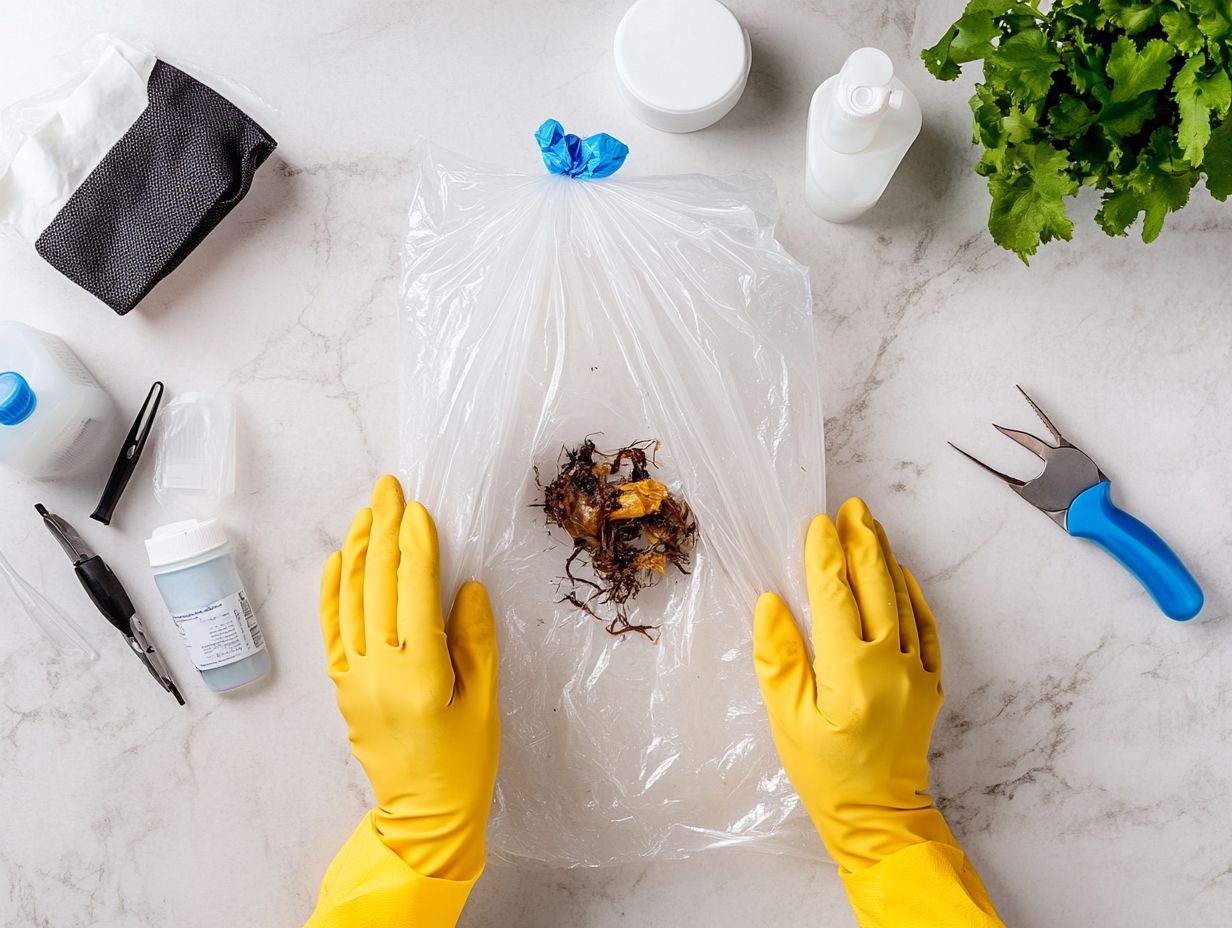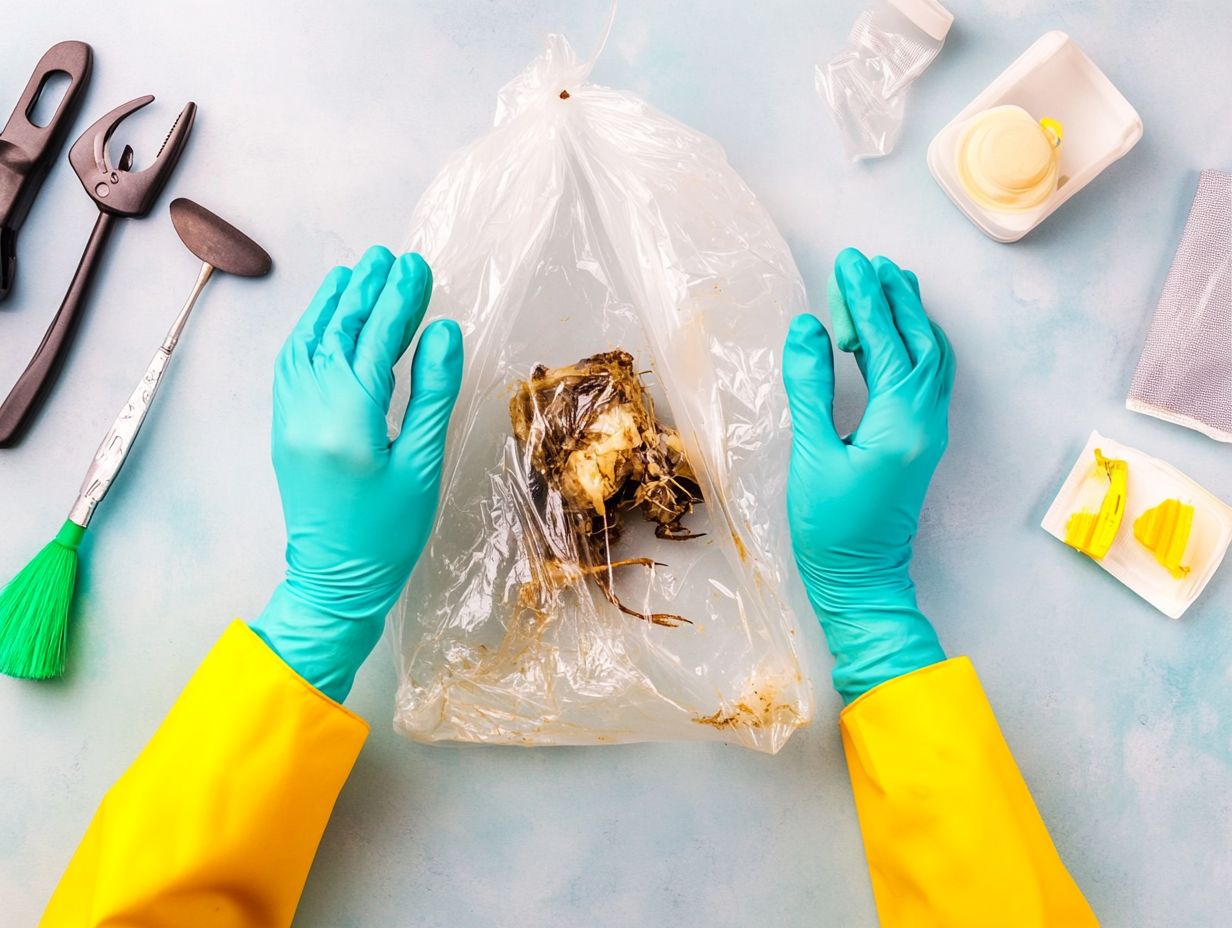How to Safely Dispose of Pest Carcasses
Proper disposal of pest carcasses is essential for maintaining a healthy environment and ensuring public health. When left unchecked, these remains can become a breeding ground for significant health risks and attract other pests. Efficient carcass disposal techniques are vital.
Let s dive into effective methods for safely disposing of pest carcasses your health and the environment depend on it! This article delves into various safe disposal methods, including burial, incineration, rendering, composting, and professional services. It also emphasizes crucial precautions such as wearing protective clothing and disinfecting the area to prevent pathogen transmission.
You will also find information on local health department regulations to ensure compliance with local laws.
Contents
- Key Takeaways:
- Why Proper Disposal of Pest Carcasses is Important
- Methods for Safe Disposal
- Essential Precautions
- Legal Considerations
- Frequently Asked Questions
- What is the best and safest way to get rid of pest carcasses?
- Can I bury pest carcasses in my backyard?
- What should I do if I have a large infestation of pest carcasses?
- Is it safe to burn pest carcasses?
- How do I prevent pests from accessing the carcasses in my trash?
- What should I do if I come into contact with a pest carcass?
Key Takeaways:

- Proper disposal of pest carcasses is crucial for both our health and the environment.
- Methods such as burial, burning, composting, or professional disposal services can be used to safely dispose of pest carcasses.
- Precautions such as using protective gear and disinfecting the area should be taken to avoid any risks while handling pest carcasses.
Why Proper Disposal of Pest Carcasses is Important
Proper disposal of pest carcasses is vital for preventing the spread of diseases and preserving environmental integrity. This is especially important in livestock farming, where disease-causing organisms can easily transfer to both live animals and humans.
By implementing effective ways to handle carcasses and following safety practices, you minimize health risks while adhering to guidelines established by local authorities and animal health officials. Neglecting proper handling can lead to serious problems, such as carcass contamination and increased mortality risks in livestock.
Therefore, grasping the significance of proper disposal methods is essential for ensuring biosecurity and promoting community health. This is crucial, especially in light of recent disease outbreaks.
Methods for Safe Disposal
There are several methods for safe carcass disposal, each with its unique advantages and challenges. These include rendering, burial, incineration, and composting. Understanding these options is essential for you as a livestock farmer, as it helps ensure compliance with local regulations while effectively managing the disposal of animal carcasses.
Rendering is a process that converts animal remains into usable products, making it an eco-friendly choice. Incineration facilities offer a swift and thorough disposal method. Burial and composting may be more cost-effective, but they can attract scrutiny due to their environmental impact, especially regarding compost environmental impact and potential health risks.
To navigate these complexities, professional disposal services are available. They ensure that you adhere to the guidelines set by health agricultural officials and local authorities.
Burial
Burial stands as a traditional method for carcass disposal. It demands your careful attention to site selection to prevent groundwater contamination and protect surrounding ecosystems.
When you choose a burial site, consider critical factors such as soil type, depth, and proximity to water sources, especially in the context of flood cleanup scenarios. This ensures decomposing remains do not leach harmful substances into the environment, preventing further pathogen transmission.
It s imperative for you to adhere to local regulations and best practices during the burial process to minimize health risks. Improper burials can trigger disease transmission and attract scavengers, posing additional threats to both wildlife and human populations.
Thus, grasping the implications of burial techniques and following established guidelines is essential for safeguarding public health and maintaining ecological balance in accordance with food safety standards.
By choosing the right disposal method, you contribute to a healthier environment and community.
Burning
Burning, or burning, stands out as a highly effective method for carcass disposal, guaranteeing the complete destruction of pathogens such as Salmonella and E. coli while minimizing health risks linked to dead animal disposal.
This process involves subjecting the remains to high temperatures, typically exceeding 1,000 degrees Fahrenheit. This effectively breaks down organic matter and neutralizes harmful bacteria and viruses to ensure proper health protocols. By utilizing burning facilities, you gain several advantages, such as drastically reducing waste volume and preventing the spread of diseases, including livestock mortality that could affect both livestock and human populations.
However, air quality concerns are essential to consider. Emissions produced during burning can contribute to atmospheric pollution and affect the agricultural health officials. Therefore, it s crucial for these facilities to strictly adhere to health regulations and employ advanced filtration systems to minimize harmful emissions, protecting public health while benefiting from these efficient waste management strategies.
Composting

Composting serves as an environmentally sustainable method for disposing of livestock carcasses. It transforms organic waste into valuable soil amendments while effectively mitigating pathogen transmission and addressing composting challenges when executed properly.
This process enriches the soil and significantly reduces the environmental footprint of farming operations. It is essential for you as a farmer to adhere to established composting protocols, like maintaining the optimal carbon-to-nitrogen ratio the right balance of carbon and nitrogen is essential for effective composting and ensuring proper aeration, especially when considering cleaning practices.
Unique challenges may arise when implementing effective composting systems, such as limited space, fluctuations in livestock populations, and the necessity to comply with local regulations, particularly concerning animal care agencies. Overcoming these hurdles is crucial for maximizing the benefits of composting, ensuring soil health, and promoting sustainable agricultural practices that align with USDA standards.
Professional Disposal Services
Professional disposal services offer specialized solutions for carcass disposal, bringing expertise in crafting a comprehensive carcass management plan while ensuring adherence to local health department regulations and health risk prevention measures.
These services not only streamline your disposal process but also incorporate effective waste management strategies that reduce environmental impact and enhance public health, especially during emergency management situations. By enlisting trained personnel who grasp the nuances of local laws, particularly those from the animal control department, you can sidestep legal complications and avoid potential fines associated with improper disposal.
In emergencies involving livestock mortality, such as disease outbreaks or natural disasters, these services become critical for effective emergency response. They provide rapid response, managing the situation safely and efficiently, thereby safeguarding both community well-being and ecosystem health, especially in the context of animal health officials.
Essential Precautions
When dealing with carcasses, it’s important to take precautions to keep everyone safe, including practicing proper health protocols. This includes donning appropriate protective clothing and adhering to rigorous hygiene practices and cleaning protocols to prevent the transmission of pathogens.
Follow the guidelines set by agricultural health officials to minimize the risks associated with the disposal of dead animals and to uphold biosecurity effectively. Effective cleaning and disinfection, along with the proper application of disinfectants, are critical steps in managing any area where carcasses are handled, thereby protecting human health and ensuring animal welfare.
Take action today to ensure safe and environmentally-friendly carcass disposal.
Protective Gear and Equipment
Using the right protective gear and equipment, such as personal protective equipment (PPE), is essential for safeguarding your health during carcass handling and ensuring food safety.
This gear typically includes gloves, masks, aprons, and eye protection. These items are carefully made to create a barrier between you and potentially hazardous materials, especially during burial incineration processes. It s vital for anyone involved in carcass disposal to don this equipment and understand its importance in upholding biosecurity and carcass management training.
By strictly following health and safety regulations, you significantly reduce the risk of disease transmission. This protects both your health and the surrounding environment, particularly concerning animal carcasses disposal.
Wearing the right protective gear keeps you safe and compliant with governmental guidelines. It promotes a culture of safety and responsibility in this critical aspect of animal husbandry.
Disinfecting the Area
After you dispose of a carcass, disinfecting the area becomes essential, particularly regarding disinfectant applications. This step eradicates any lingering pathogens and prevents their transmission to other animals or humans, crucially addressing animal welfare.
To apply disinfectants properly, start by thoroughly cleaning the surfaces before introducing the solution. This ensures adherence to cleaning disinfection standards. Removing all organic matter is critical, as it can hinder the disinfectant’s effectiveness, especially in the context of animal care agencies.
Always follow the manufacturer’s instructions regarding dilution how much water to mix with the disinfectant and contact time the duration the disinfectant needs to be on the surface to maximize germicidal action during carcass management activities.
The significance of cleaning and disinfection is paramount. This is especially true for preventing outbreaks of diseases, including those affecting livestock disease transmission that can impact both livestock and human health.
Implementing rigorous hygiene practices such as using personal protective equipment (PPE) and frequently sanitizing tools plays a vital role in maintaining a safe environment after carcass disposal. This is particularly relevant for COVID-19 precautions. This vigilance protects public health, enhances animal welfare, and ensures compliance with Veterinary Compliance Assistance.
Legal Considerations

Understanding local regulations and restrictions concerning carcass disposal is crucial for livestock farmers. This knowledge ensures compliance with health department guidelines and helps you avoid potential penalties.
Local Regulations and Restrictions
Local regulations regarding carcass disposal can differ significantly by region. It s crucial for you to gain a comprehensive understanding of the requirements set by the health department to remain compliant and manage carcasses effectively.
For anyone involved in livestock operations, grasping these regulations isn’t just important it s essential. Ignoring them could lead to legal penalties and pose environmental risks.
Developing a robust carcass management plan aligns with these legal frameworks. It promotes public health and supports environmental sustainability.
This plan should encompass various disposal methods, including:
- Burial
- Incineration
- Rendering
It s important to consider the specific guidelines outlined for each method. By proactively assessing local ordinances, you can implement best practices that safeguard community welfare and ensure the proper handling of animal remains, ultimately mitigating any potential risks.
Emergency Response Protocols
Emergency response protocols are essential for managing carcass disposal during crises, such as natural disasters or disease outbreaks. By adhering to these protocols, you can effectively prevent the transmission of livestock diseases and safeguard public health.
The success of these protocols relies heavily on the collaborative efforts of various agencies, particularly animal control departments and officials who oversee livestock health. These teams are responsible for swiftly assessing the situation and determining safe disposal methods. They ensure compliance with environmental regulations and, in scenarios like flood cleanup, they pinpoint contaminated areas. Rapid removal of carcasses is crucial to mitigate risks of diseases that can be spread from animals to humans.
This coordinated approach enhances community safety and builds public confidence in the resilience of local and regional health systems. Ultimately, well-structured emergency response protocols are invaluable in minimizing potential health hazards in the aftermath of a disaster.
Frequently Asked Questions
What is the best and safest way to get rid of pest carcasses?
The best and safest way to get rid of pest carcasses is to follow the guidelines set by your local waste management agency. Generally, they recommend double-bagging the carcasses in plastic bags, tying them tightly, and then placing them in your regular trash bin.
Can I bury pest carcasses in my backyard?

It is not recommended to bury pest carcasses in your backyard as it can attract other pests and potentially contaminate your soil. It is best to check your local waste management agency’s website for specific disposal instructions.
What should I do if I have a large infestation of pest carcasses?
If you have a large number of pest carcasses to dispose of, it is best to contact a professional pest control company. They have the proper equipment and protocols to safely remove and dispose of the carcasses.
Is it safe to burn pest carcasses?
Burning pest carcasses is not recommended as it can release harmful toxins into the air and is illegal in some areas. It is best to follow the disposal guidelines set by your local waste management agency.
How do I prevent pests from accessing the carcasses in my trash?
To prevent pests from accessing the carcasses in your trash, tie the plastic bags tightly and dispose of them in a sealed bin with a lid. You can also sprinkle baking soda or borax in the bottom of the bin to repel pests.
What should I do if I come into contact with a pest carcass?
If you accidentally come into contact with a pest carcass, wash your hands thoroughly with soap and warm water. If any symptoms or reactions occur, seek medical attention immediately.
For further assistance, consult with professionals for pest control to enhance community safety.






